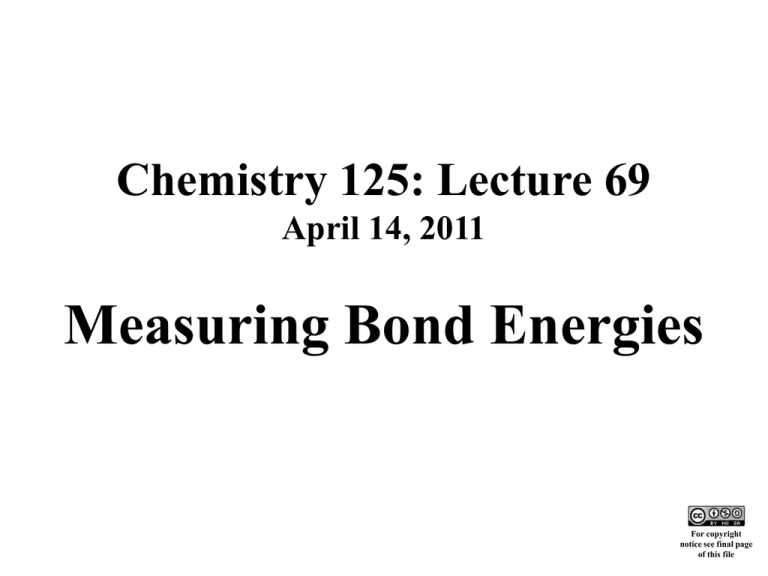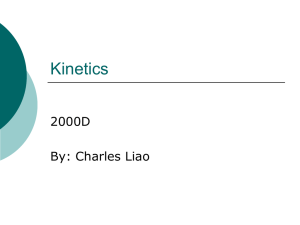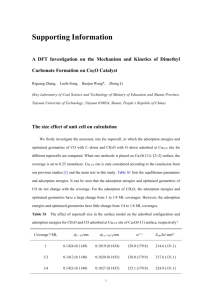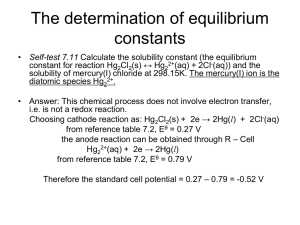
Chemistry 125: Lecture 69
April 14, 2011
Measuring Bond Energies
This
For copyright
notice see final page
of this file
Are
Bond Energies
“Real” ?
Bond Dissociation Energies
BondDissn Energies
115
84
85
72
72
58
57
99
111
113
90
89
89
105
111
127
85
85
97
74
122
85
74
73
84
63
59
72
57
56
67
51
46
54
123
136.2
91
92
94
best values as of 2003
Presentation by
Prof. G. Barney Ellison
University of Colorado, Boulder
Definition of D0
@ 100 kcal mol-1 or 4 eV
Energy, V(r) / kcal mol-1
D0(RH) = Bond Dissociation Energy
A+ B
E0 (A) + E0(B)
D0 (AB)
E 0 (AB)
re
A-B bond length, r (Å)
How could specific bond energies be measured?
Consider methyl alcohol
CH3O-H CH3O• + •H
or
H-CH2OH H• + •CH2OH
or
CH3-OH CH3• + •OH
One way to measure BDE:
CH3OH + F–
He
Acidity/Negative Ion Cycle
Kkeq
1
CH3O– + HF
k-1
–CH OH
2
Experiment of Veronica Bierbaum
time
CHF3–O–
CHHF
3ON=O
never !
CHHF
3OH
Monitor
growth of
CHF3–O–
m/z 31
19
Add
a flowing
stream
of Heofcontaining
Add HF
CH3to
OH
to a flowing
stream
He
- has appeared
– and see
– and
CH
O
how
much
F
containing
F
see
how
much
CH3O3
downstream
varioustimes
timeslater.
later.
has formed atatvarious
This
gives
This
gives
k1. k-1.
c) Acidity/Negative Ion Cycle
Kkeq
1
CH3OH + F–
CH3O– + HF
k-1
Bierbaum
to find
?
“known”
DacidH298(CH3O-H) = DH298(CH3O-H) + IE(H) – EA(CH3O)
The equilibrium constant Keq = k1/k-1 gives the difference in
acidity between CH3OH and HF. Since the acidity of HF is
known [370.424 ± 0.003 kcal mol-1], this experiment
determines the energy required for acid dissociation of CH3OH.
Acid
CH3OH
CH3O–
+
H+
which can be thought of as:
CH3OH
Dissn
Ionization
Energy
-Electron
Affinity
CH3O•
+
H•
Anion Photoelectron Spectrum Measures
Electron Affinity as Electron Binding Energy:
laser light energy
CH3O— + hw0 CH3O + e— (KE)
If the product
radical
is vibrating, the
Measured
photo-electron kinetic
Kinetic Energy of
energy will be smaller
ejected “photoelectron”
and the measured
electron binding
energy will be larger.
CH O• (no extra vibration)
3
Electron
Binding
Energy
CH3O– (no extra vibration)
Engelking, Ellison, Lineberger, J. Chem. Phys. 69, 1826
(1978)
CH3O— + hw0 CH3O + e—
no extra
vibration @
0.968 eV
Photoelectron
counts
EA(CH3O) = (2.540 0.968) = 1.572 ±
0.004 eV
Electron Kinetic Energy/eV
c) Acidity/Negative Ion Cycle
DacidH298(CH3OH) = DH298(CH3O-H) + IE(H) – EA(CH3O)
DacidH298(CH3OH) = 381.9 ± 0.5 kcal mol-1
(Bierbaum)
IE(H) = 13.59844 eV or (at 298K) 313.6 kcal mol-1
EA(CH3O) = 1.572 ± 0.004 eV or 36.3 ± 0.5 kcal mol-1
(Ellison et al.)
DH298(CH3O-H) = 104.6 ± 0.6 kcal mol-1
c) Acidity/Negative Ion Cycle
Problems ?
Can’t apply to H-CH2OH
any base you can think of always gets most acidic proton
CH3OH
(good)
CH3O– + H+
electron on O atom
–CH2OH + H+
electron on C atom
(bad)
DacidH298(H-CH2OH) = DH298(H-CH2OH) + IE(H) – EA(CH2OH)
no gas-phase [CH2OH]–
CH2OH + e–
can’t measure DacidH298(H-CH2OH) & can’t measure EA(CH2OH)
c) Acidity/Negative Ion Cycle
Problems ?
Can’t apply to H-CH2OH
any base you can think of always gets most acidic proton
CH3OH
[CH3O]– + H+
[CH2OH]– + H+
DacidH298(H-CH2OH) = DH298(H-CH2OH) + IE(H) – EA(CH2OH)
no gas-phase [CH2OH]–
CH2OH + e–
can’t measure DacidH298(H-CH2OH) & can’t measure EA(CH2OH)
However:
CH3OH + Cl
k1
CH2OH + HCl
k-1
measure Kequi via k1 and k-1 to extract DrxnH298 DH298(H-CH2OH) - DH298(HCl)
DH298(HCl) = 103.15 ± 0.03 kcal mol-1
1
DH298(H-CH2OH) = 96.1 ± 0.2 kcal mol-
Uses of heats of formation, DfH298(R) ?
What is the C-O bond in methanol? CH3-OH CH3 •
What is ?
•OH
or
Uses of heats of formation, DfH298(R) ?
What is the C-O bond in methanol? CH3-OH CH3 •
•OH
DH298(CH3 -H) = DfH298(CH3) + DfH298(H) - DfH298(CH4)
Radical kinetics/PIMS studies DH298(CH3 -H) = 104.99 ± 0.03 kcal1 & DH
f 298(H) is known from D0(H2)
Classical thermochemistry finds DfH298(CH4)
J. B. Pedley, R. D. Naylor, and S. P. Kirby, Thermochemistry of
Organic Compounds; 2nd ed.; Chapman and Hall: New York,
1986.
DfH298(CH3) = 35.05 ± 0.07 kcal mol-1
BDE(H2O) DfH298(OH) = 8.91 ± 0.07 kcal mol-1
Pedley et al provides DfH298(CH3OH)
DH298(CH3 -OH) = DfH298(CH3) + DfH298(OH) - DfH298(CH3OH)
DH298(CH3 -OH) = 92.1 ± 0.1 kcal mol-1
Ellison I
Ellison II
c) Acidity/Negative Ion Cycle
DacidH298(CH3OH) = DH298(CH3O-H) + IE(H) – EA(CH3O)
DacidH298(CH3OH) = 381.9 ± 0.5 kcal mol-1
(Bierbaum)
IE(H) = 13.59844 eV or (at 298K) 313.6 kcal mol-1
EA(CH3O) = 1.572 ± 0.004 eV or 36.3 ± 0.5 kcal mol-1
(Ellison et al.)
DH298(CH3O-H) = 104.6 ± 0.6 kcal mol-1
Bond Energies of Alcohols/kcal mol-1
DH298(CH3O-H) = 104.6 ± 0.7
CH3O• + •H
DH298(CH3CH2O-H)
= 104.7 ± 0.8
DH298((CH3)2CHO-H) = 104.6 ± 0.7
DH298((CH3)3CO-H)
= 106.3 ± 0.7
Bond Energies of Alcohols/kcal mol-1
DH298(CH3O-H) = 104.6 ± 0.7
CH3O• + •H
DH298(CH3CH2O-H)
= 104.7 ± 0.8
DH298((CH3)2CHO-H) = 104.6 ± 0.7
DH298((CH3)3CO-H)
= 106.3 ± 0.7
DH298(C6H5O-H)
= 85.8 ± 0.1
Bond Energies of Alcohols/kcal mol-1
DH298(CH3O-H) = 104.6 ± 0.7
CH3O• + •H
DH298(CH3CH2O-H)
= 104.7 ± 0.8
DH298((CH3)2CHO-H) = 104.6 ± 0.7
DH298((CH3)3CO-H)
= 106.3 ± 0.7
DH298(C6H5O-H)
= 85.8 ± 0.1
DH298(HOO-H)
DH298(CH3OO-H)
DH298(CH3CH2OO-H)
DH298(CH3)3COO-H)
= 87.8 ± 0.5
= 88 ± 1
= 85 ± 2
= 84 ± 2
HOO• + •H
Bond Energies of Alcohols/kcal mol-1
DH298(CH3O-H) = 104.6 ± 0.7
DH298(CH3CH2O-H)
= 104.7 ± 0.8
DH298((CH3)2CHO-H) = 104.6 ± 0.7
DH298((CH3)3CO-H)
= 106.3 ± 0.7
DH298(C6H5O-H)
= 85.8 ± 0.1
DH298(HO-H)
= 118.82 ± 0.07
30.2 ± 0.2
•CH2
O
106.3 ± 0.3
H
104.6 ± 0.7
96.1 ± 0.3
H
CH2
HO• + •H
H
O
92.1 ± 0.1
H
22.0 ± 0.9
CH2
O•
90.5 ± 0.9
What is a bond strength?
Consider methane:
CH4 C + 4 H
DatomizationH298(CH4) = 397.5 kcal mol-1
DavgH298(CH4) = 99.4 kcal mol-1
DH298/kcal mol-1
Species
Heat of Formation
DfH298[CH3]
CH3 -H
104.99 ±
CH2-H
110.4 ± 0.2
DfH298[CH2]
CH-H
101.3 ± 0.3
DfH298[CH]
C-H
80.9 ± 0.2
0.03
DfH298[C]
a) No bond equals the “average” C-H bond … careful.
b) The sum of the BED’s is 397.5 ± 0.6 kcal mol-1.
works!
1stLaw really
Boulder Ion Gang, 1980
Herman Bierbaum
Acknowledgements
Leone
Ronnie Bierbaum
Ellison
Bob Damrauer
Lineberger
Barney Ellison
Carl Lineberger
National Science Foundation
DePuy
Ferguson
2
Engelking, Ellison, Lineberger, J. Chem. Phys. 69, 1826
(1978)
no extra
vibration @
0.968 eV
CH3O— + hw0 CH3O + e—
Photoelectron
counts
EA(CH3O) = (2.540 0.968) = 1.572 ±
0.004 eV
?
Electron Kinetic Energy/eV
Anion Photoelectron Spectrum Measures
Electron Affinity as Electron Binding Energy:
laser light energy
CH3O— + hw0 CH3O + e— (KE)
If the product
radical
is vibrating, the
Measured
photo-electron kinetic
Kinetic Energy of
energy will be smaller
ejected “photoelectron”
and the measured
electron binding
energy will be larger.
CH O• (no extra vibration)
3
Electron
Binding
Energy
Vibrationally excited CH3O- gives “hot band”
leaving more of hw0 energy for ejected electron.
CH3O– (no extra vibration)
Engelking, Ellison, Lineberger, J. Chem. Phys. 69, 1826
(1978)
CH3O— + hw0 CH3O + e—
no extra
vibration @
0.968 eV
Photoelectron
counts
EA(CH3O) = (2.540 0.968) = 1.572 ±
0.004 eV
transitions to
vibrationally
excited states
of CH3O•
radical
transition from
vibrationally
excited state of
CH3O- anion
(weaker
vibration)
Electron Kinetic Energy/eV
End of Lecture 69
April 15, 2011
Copyright © G. B. Ellison 2011. Some rights reserved. Except for cited third-party materials, all content is licensed under a
Creative Commons License (Attribution-NonCommercial-ShareAlike 3.0).
Use of this content constitutes your acceptance of the noted license and the terms and conditions of use.
Third party materials may be subject to additional intellectual property notices, information, or restrictions.
The following attribution may be used when reusing material that is not identified as third-party content:
G. B. Ellison, Chem 125. License: Creative Commons BY-NC-SA 3.0








